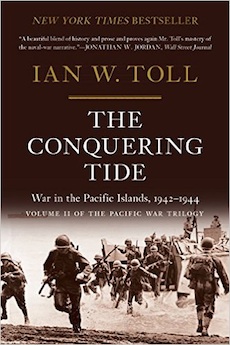By Allen D. Boyer
“The Pacific War was the largest, bloodiest, most costly, most technically innovative, and most logistically complex amphibious war in history,” Ian Toll writes. “To roll back the tide of Japanese conquests, the Allies would be required to seize one island after another, advancing across thousands of miles of ocean in two huge parallel offensives on either side of the equator.”
The Conquering Tide, the second volume of a trilogy on World War II in the Pacific, begins on Guadalcanal, in the summer of 1942, with a British colonial officer hearing American voices on his radio and watching green-clad troops swarming ashore. It sweeps north to the Japanese citadel of Rabaul, leaps to the Gilbert and Marshall Islands, and broods over the empty ocean where American submarines hunted Japanese freighters. It ends in June and July 1944. While Allied forces were fighting their way ashore in Normandy, another climactic campaign was being fought, half a world away. The United States Navy landed troops on Saipan and Guam, and its aviators shot down hundreds of Japanese warplanes on a single day, between dawn and dusk on June 19. “Historians would call it the first day of the Battle of the Philippine Sea, but to the aviators it was always the ‘Marianas Turkey Shoot.’”
Soldiers and airmen will note that this book is about Navy warships and Marines. (Toll devotes five chapters to Guadalcanal, one solitary sentence to Buna – a campaign fought at the same time, just as large and just as bloody, in which American recruits and Australian veterans stopped the Japanese offensive in New Guinea.) This perspective may be myopic, but otherwise Toll is uncommonly keen-eyed. He provides brilliant sketch portraits of such admirals as Ernest King, Isoroku Yamamoto, Bill Halsey, and Chester Nimitz. He superbly evokes life on the islands across which the war swept: the coconut plantations and mountain jungles of the Solomons, the sun-bleached blood-soaked sandspit of Tarawa, and – most pungently – wartime Hawaii. While divers and salvage crew strained to raise the battleships sunk at Pearl Harbor, Toll writes, downtown Honolulu had become a brassy boomtown:
“The vice district ran along Hotel Street from the ‘Y’ to the river, a neighborhood of brash neon, booming jukeboxes and peeling paint . . . . Men stood in long lines for hot dogs, popcorn, ice cream, Coca-Cola, tattoos, massages, haircuts, pinball machines, shooting galleries, baseball batting cages, pool table, and photos with a hula dancer. Fifteen cents would buy a bowl of sai min – pork and noodles – but a customer had to eat on his feet while being jostled on the crowded sidewalk.”
In this book there is something of From Here to Eternity as well as The Caine Mutiny. Sprawling, intense, and ambitious, this history reflects the war it covers.
Allen Boyer (ΦBK, Vanderbilt University, 1977) is a lawyer and writer in New York City. He is currently editing a wartime diary that his father kept while serving in New Guinea and the Philippines with the Fifth Air Force. Vanderbilt University is home to the Alpha of Tennessee Chapter of Phi Beta Kappa.




